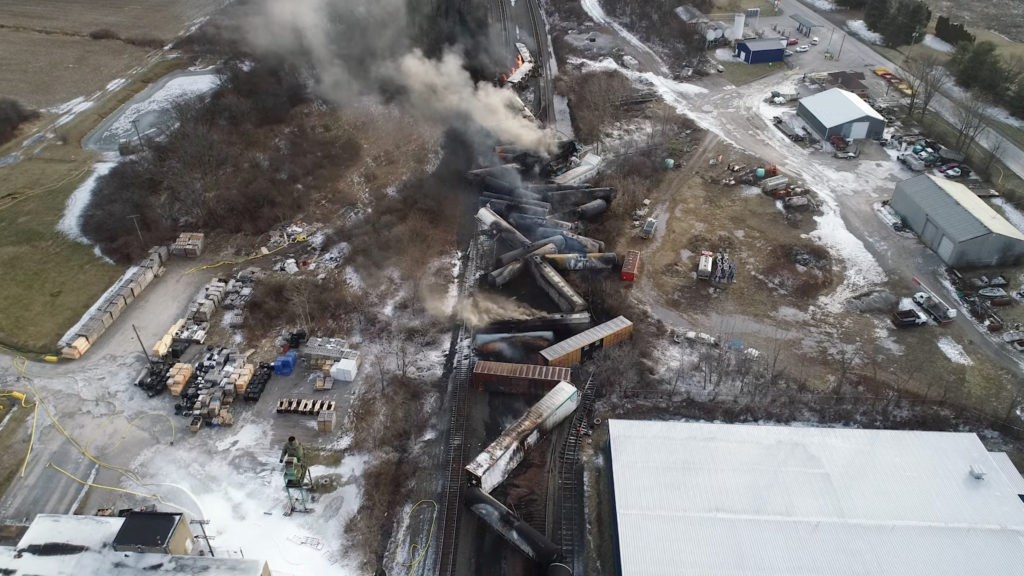Ohio Train Derailment: Prolonged Exposure To Toxic Chemicals In Buildings

Table of Contents
Types of Chemicals Released and Their Persistence
The Ohio train derailment involved the release of a variety of hazardous materials, most notably vinyl chloride, butyl acrylate, and ethylene glycol monobutyl ether. These chemicals present different levels of volatility and persistence, meaning their longevity and impact on indoor environments vary considerably. Vinyl chloride, a known carcinogen, is highly volatile, meaning it evaporates quickly. However, residual traces can still linger in porous materials such as carpet, upholstery, and drywall. Butyl acrylate, a less volatile chemical, can persist for longer periods, adhering to surfaces and potentially leaching into the air over time. Ethylene glycol monobutyl ether, while less acutely toxic, can still cause respiratory irritation and other health problems with prolonged exposure.
- Volatility and Longevity: The volatility of each chemical significantly impacts its longevity in indoor environments. Highly volatile chemicals may dissipate quickly, but less volatile chemicals can persist for weeks, months, or even longer, depending on factors such as temperature, humidity, and air circulation within the building.
- Surface Residue: Even after cleaning efforts, microscopic traces of these chemicals may remain on surfaces, particularly porous materials. These residual amounts, while potentially lower in concentration, could still contribute to cumulative exposure over extended periods.
- Research and Similar Scenarios: Research on the long-term presence of similar chemicals in the aftermath of industrial accidents and chemical spills highlights the potential for prolonged contamination and associated health risks. Studies examining the long-term impact of such disasters underscore the need for comprehensive testing and remediation strategies.
Health Risks Associated with Prolonged Exposure
Prolonged exposure to the chemicals released in the Ohio train derailment can lead to a range of acute and chronic health problems. Short-term effects may include respiratory irritation, headaches, nausea, and dizziness. However, more concerning are the potential long-term consequences, which may not manifest immediately.
- Respiratory Issues: Exposure to vinyl chloride and other chemicals can cause chronic respiratory problems, including asthma, bronchitis, and decreased lung function. Butyl acrylate can also irritate the lungs and airways, leading to persistent coughing and shortness of breath.
- Neurological Problems: Some of the released chemicals are associated with neurological problems, including impaired cognitive function, memory loss, and increased risk of neurological disorders. Long-term exposure to low levels of these chemicals could have cumulative effects, worsening these conditions over time.
- Other Health Complications: The cumulative effects of low-level, long-term exposure are particularly concerning. This exposure can affect various organ systems, increasing the risk of cancer, liver damage, and other health complications. Children, the elderly, and individuals with pre-existing conditions are particularly vulnerable to the effects of these chemicals.
Testing and Remediation Strategies
Given the potential for long-term health risks, comprehensive testing and remediation of affected buildings are crucial. Air and surface testing should be conducted to accurately assess the levels of contamination. This involves sampling air and surface materials to identify the presence and concentration of specific chemicals.
- Testing and Remediation Professionals: Individuals concerned about contamination should contact certified environmental testing and remediation professionals. These specialists can conduct thorough assessments, identify contaminated areas, and recommend appropriate remediation strategies.
- Remediation Techniques: Remediation strategies may include air filtration systems to remove airborne contaminants, deep cleaning of surfaces using specialized cleaning agents, and in some cases, more extensive treatments such as the removal and replacement of contaminated materials.
- Government Support and Resources: Affected residents should explore available government support and resources, which may include financial assistance for testing and remediation, as well as access to healthcare services. State and federal agencies may offer programs designed to help communities recover from environmental disasters.
Legal and Regulatory Implications
The Ohio train derailment has significant legal and regulatory implications for residents and businesses affected by the release of toxic chemicals. Individuals may have legal recourse to seek compensation for property damage, medical expenses, and other losses incurred as a result of the derailment.
- Legal Recourse: Legal action may include filing lawsuits against the responsible parties, including the railroad company and potentially other involved entities. Consult with legal professionals specializing in environmental law to understand your rights and available legal options.
- Regulatory Response and Investigations: Government agencies are investigating the causes of the derailment and implementing regulatory changes to prevent similar incidents in the future. These investigations will help to determine liability and inform future safety regulations.
- Legislation and Environmental Protection Acts: The event highlights the importance of existing environmental protection acts and legislation, along with the need for potential future adjustments to better protect communities from such hazards. Ongoing lawsuits and potential compensation will likely shape future regulatory changes and influence industry practices.
Conclusion
The Ohio train derailment presents a significant public health challenge due to the prolonged exposure to toxic chemicals in buildings. Understanding the specific chemicals involved, their persistence in various building materials, and the associated short-term and long-term health risks is paramount for implementing effective mitigation strategies. Thorough testing, appropriate remediation techniques (such as professional air quality testing and remediation services), and exploring available legal recourse are essential for safeguarding the health and well-being of affected communities. Long-term monitoring and ongoing support are vital to address the lasting impact of this environmental disaster. The potential for long-term health problems emphasizes the critical need for prompt action.
Call to Action: If you live in an area affected by the Ohio train derailment and suspect prolonged exposure to toxic chemicals in your building, seek professional testing and remediation immediately. Don't hesitate to utilize available government resources, explore legal options to protect your health and well-being, and stay informed about the long-term effects of toxic chemical exposure from the Ohio train derailment. Your health and the health of your community depend on proactive steps to address this ongoing situation.

Featured Posts
-
 Upcoming Horror Reboot Could It Outperform The New Stephen King Adaptation
May 05, 2025
Upcoming Horror Reboot Could It Outperform The New Stephen King Adaptation
May 05, 2025 -
 Re Examining The Count Of Monte Cristo A Review For Modern Readers
May 05, 2025
Re Examining The Count Of Monte Cristo A Review For Modern Readers
May 05, 2025 -
 Predicting The 2025 Louisiana Derby Odds Key Horses And Road To Kentucky Derby
May 05, 2025
Predicting The 2025 Louisiana Derby Odds Key Horses And Road To Kentucky Derby
May 05, 2025 -
 Breaking Free How Advanced Electric Motors Can End Chinas Dominance
May 05, 2025
Breaking Free How Advanced Electric Motors Can End Chinas Dominance
May 05, 2025 -
 Ufc Des Moines Predictions Expert Picks And Betting Odds
May 05, 2025
Ufc Des Moines Predictions Expert Picks And Betting Odds
May 05, 2025
